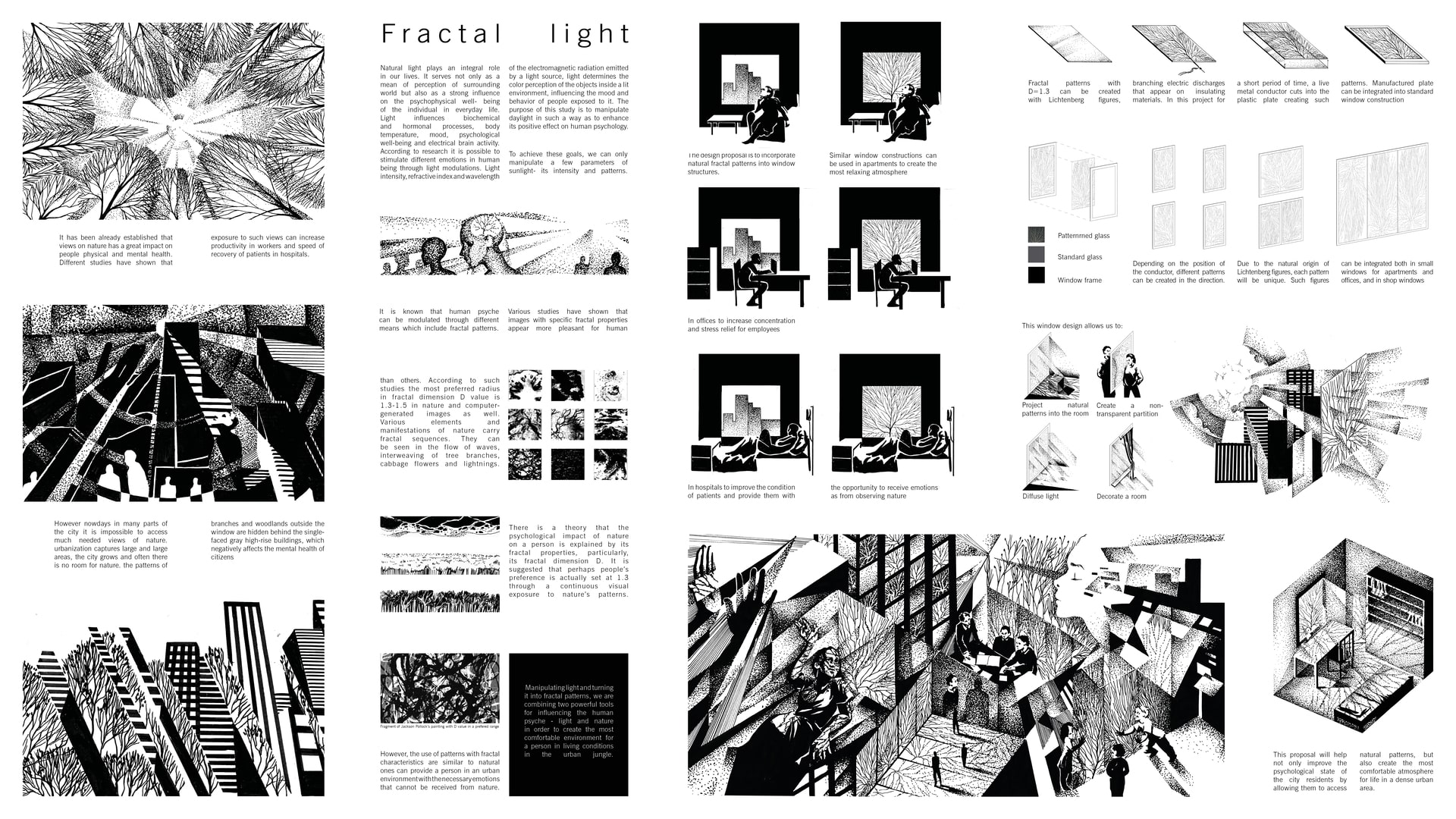Project Description
Natural light plays an integral role in our lives. It serves not only as a mean of perception of surrounding world but also as a strong influence on the psychophysical well- being of the individual in everyday life. Light influences biochemical and hormonal processes, body temperature, mood, psychological well-being and electrical brain activity.[3] According to research it is possible to stimulate different emotions in human being through light modulations [2]. Light intensity, refractive index and wavelength of the electromagnetic radiation emitted by a light source, light determines the color perception of the objects inside a lit environment, influencing the mood and behavior of people exposed to it. [8] The purpose of this study is to manipulate daylight in such a way as to enhance its positive effect on human psychology. To achieve these goals, we can only manipulate a few parameters of sunlight- its intensity and patterns. It is known that human psyche can be modulated through different means which include fractal patterns. Various studies have shown that images with specific fractal properties appear more pleasant for human than others [7]. According to such studies the most preferred radius in fractal dimension D value is 1.3-1.5 in nature and computer-generated images as well. Various elements and manifestations of nature carry fractal sequences. They can be seen in the flow of waves, interweaving of tree branches, cabbage flowers and lightnings. There is a theory that the psychological impact of nature on a person is explained by its fractal properties, particularly, its fractal dimension D. It is suggested that perhaps people’s preference is actually set at 1.3 through a continuous visual exposure to nature’s patterns.[10] It has been already established that views on nature has a great impact on people physical and mental health. Different studies have shown that exposure to such views can increase productivity in workers and speed of recovery of patients in hospitals.[9] However nowadays in many parts of the city it is impossible to access much needed views of nature. The patterns of branches and woodlands outside the window are hidden behind the single-faced gray high-rise buildings, which negatively affects the mental health of citizens However, the use of patterns with fractal characteristics are similar to natural ones can provide a person in an urban environment with the necessary emotions that cannot be received from nature. Manipulating light and turning it into fractal patterns, we are combining two powerful tools for influencing the human psyche - light and nature in order to create the most comfortable environment for a person in living conditions in the urban jungle. The design proposal is to incorporate natural fractal patterns into window structures. Such window constructions can be used in apartments and offices to decrease stress levels, hospitals to improve the condition of patients. Fractal patterns with D=1.3 can be created with Lichtenberg figures, branching electric discharges that appear on insulating materials. these patterns are created by inserting a voltage conductor into a plastic plate. Manufactured plate can be integrated into standard window construction Depending on the position of the conductor, different patterns can be created in the direction. Due to the natural origin of Lichtenberg figures, each pattern will be unique. Such figures can be integrated in windows of various dimensions and styles. Such window constructions will softly diffuse light and project patterns on the interior. This proposal will help not only improve the psychological state of the city residents by allowing them to access natural patterns, but also create the most comfortable atmosphere for life in a dense urban area. 1. Aks, D.J., and Sprott J.C/ (1996) quantifying aesthetic preference for chaotic patterns Journal of the empirical studies of the arts, 4, 1-16. 2. Light Sensitivity as Related to Age and Sex. Perceptual Motor Skills, 24, 1275-1288. 3. Mahnke, F., & Mahnke, R. (1987). Color and Light in Man-Made Environments. New York: Van Nostrand Reinhold Co 4. Rosella Tomassoni, Giuseppe Galetta, Eugenia Treglia. Psychology of Light: How Light Influences the Health and Psyche. Psychology, 2015, 6, 1216-1222 5. Reduction of Physiological Stress Using Fractal Art and Architecture Taylor, R. P. Leonardo, Volume 39, Number 3, June 2006, pp. 245-251 (Article)) 6. Taylor, R. (2001). Architects reaches for the clouds. How fractals may figure in our appreciation of a proposed new building. Nature, 410, 18. 7. Taylor, R. P., Newell, B., Spehar, B., & Clifford, C. W. G. (2001). Fractals: A resonance between art and nature., Symmetry: Art and Science, 1, 194–18197 8. Veitch & Newsham, 1998; Boyce et al., 2000 9. View Through a Window May Influence Recovery from Surgery (Science, 1984, T. 224, p. 420-421). 10. Branka Spehar, Colin W.G.Clifford, Ben R. Newell, Richard P. Taylor. Universal aesthetic of fractals. Computers & Graphics 27 (2003) 813-820
